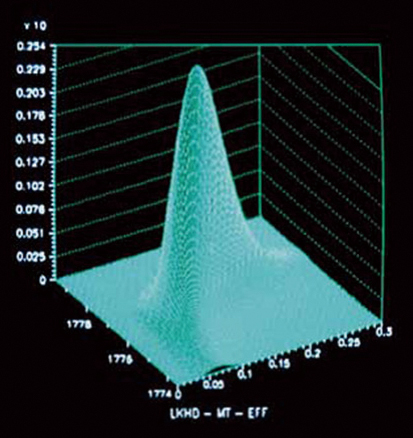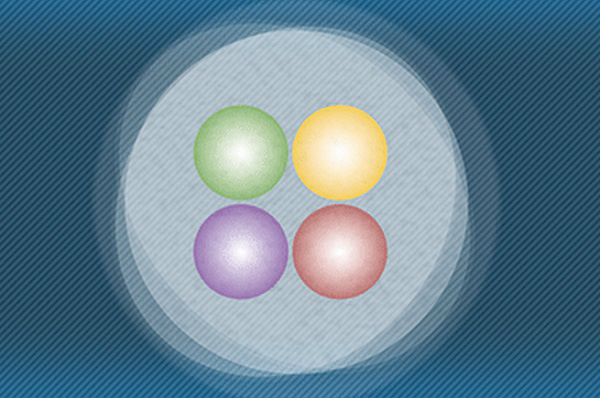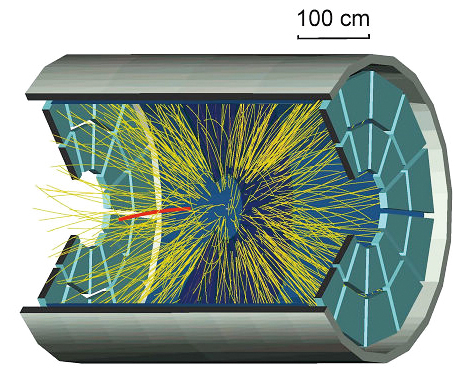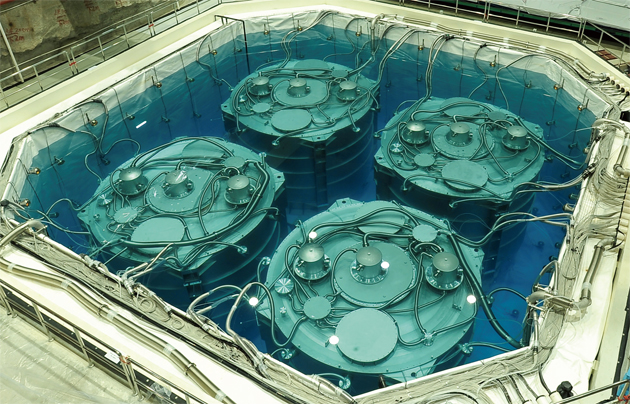Our understanding of the microscopic universe has gone far beyond the atomic level — now we know even the neutron or proton, once thought to be “elementary particles”, can be divided into smaller building blocks, for example quacks. Also known as high-energy physics, particle physics is dedicated to studying the subatomic structure and properties of matter, and understanding how such subnuclear particles interact with each other in high-energy conditions.
To this end, we might need to accelerate charged particles, like electrons and positrons, to speeds near to that of light, and let them collide with each other; or use them to bombard some targets. By analyzing the information recorded on the product particles from such big clashes, including the energy, the trajectories and masses of them, and also the daughter particles from their possible decay, we can infer the subatomic structure of matter, the properties and motion of elementary particles, and the underlying physical laws. We can otherwise explore subnuclear particles by observing and analyzing the cosmic rays, figuring out what possibly have been traveling in the interstellar medium and approached the space surrounding our planet.
Thanks to the fast advancement of science infrastructure like accelerators and big detectors, over the past four decades scientists at the Chinese Academy of Sciences (CAS) have made a series of discoveries of international importance in hadron physics, nuclear physics, neutrino physics and other frontiers of high-energy physics. Particularly, we have found some important new elementary particles, and synthesized some new nuclides.
New Particles Produced on BEPC and BESIII
Since the 1990s, the CAS Institute of High-energy Physics (IHEP) has made precise measurement of the mass of τ lepton, as well as the hadron production in the energy range of 25 GeV. IHEP has also successfully identified a new particle, the X(1835), resulting from the experiments on the Beijing Electron and Positron Collider (BEPC) and the Beijing Spectrometer (BES).

BES made precise measurements of the cross sections of the electron-position annihilations in the center-of-mass energies ranging from 2 GeV to 5 GeV. The experiment improved the precision of the Fine Structure Constant α (Mz2) by a factor of two, and greatly improved the prediction accuracy of the Standard Model for the Higgs mass. (Credit: IHEP)

The precise measurement of the τ lepton mass was very important for the verification of lepton universality in the Standard Model. The result reduced the mass value by three standard deviations and the uncertainty was reduced by a factor of 10. (Credit: IHEP)
In 2013, an experiment joined by over 350 physicists from 11 countries on BESIII, the upgraded version of BESII, led to the first observation of a “tetraquack” hadron Zc(3900), subverting the traditional belief that a particle of matter could only be composed of either two or three quacks. This discovery was ranked first among the 11 important achievements picked out by Physics, a journal sponsored by the American Physical Society in the same year.

The tetraquack hadron Zc (3900) discovered on BESIII (Image: IHEP)

An illustration of Zc(3900), the tetraquack particle identified on BESIII (Credit: IHEP)
Synthesis of New Super-heavy Isotopes at HIRFL
In 1992, scientists from the CAS Shanghai Institute of Nuclear Research (SINR) obtained a new nuclide, the Platinum-202 (202Pt) on the Heavy Ion Research Facility at Lanzhou (HIRFL), which produces medium- to high-energy ion beams. This success marked the first new isotope synthesized by Chinese scientists.
Since the 1990s, another institution under the umbrella of CAS, the Institute of Modern Physics (IMP) in Lanzhou, Gansu Province has artificially synthesized a total of 34 new nuclides, and successfully measured the masses of a series of short-lived nuclei with high precision. IMP has also established an international evaluation center for data on nuclei masses.
Anti-helium-4, the Heaviest Anti-nucleus
In 2011, the international community of particle physicists scored a milestone achievement – the successful identification of the heaviest anti-matter particle, the anti-helium-4 (anti-4H). The international team working at the STAR detector of RHIC, the Relativistic Heavy Ion Collider at the U.S. Department of Energy’s Brookhaven National Laboratory (BNL), identified this anti-nucleus and described the discovery in a paper published in Nature on April 24, 2011.

The STAR collaboration detected 18 examples of the unique “signature” of the antihelium-4 nucleus based on the Time of Flight (TOF) detector, which was designed and made by the STAR TOF project team from China and US. (Credit: SINAP)
As partners in the twelve-country STAR collaboration, several CAS Institutions, including the CAS Shanghai Institute of Applied Physics (SINAP), the heirs of SINR, the University of Science and Technology of China (USTC), and the Institute of Modern Physics (IMP), played a key role in the discovery. The Chinese team designed and built the Time of Flight detector of RHIC, based on which the measurement of anti-4H, also known as anti-alpha, was made. The Chinese team also attended the data processing of the experiment.
RHIC is a particle accelerator used to simulate and study conditions of the early universe just after the Big Bang. The research is expected to shed some light on one of the greatest mysteries of physics: Why our universe appears to be made entirely of ordinary matter, whilst matter and antimatter are understood to have been created in equal amounts at the time of the Big Bang.
New “Flavor” of Neutrino
The year 2012 witnessed the discovery of a new “flavor” of neutrino – the third type of neutrino oscillation as a result from the work at Daya Bay Neutrino Experiment headed by IHEP.

The neutrino detector immersed in water at the Daya Bay Neutrino Experiment (Image: IHEP)
The Daya Bay Neutrino Experiment, based at the Daya Bay nuclear power plant in Guangdong Province of southern China, started running in 2011. In March 2012, the experimental collaboration announced the discovery of the third type of neutrino oscillation, and also the precise measurement of the neutrino mixing angle θ13. This discovery, listed among the annual 10 science breakthroughs by Science in 2012, earned the team the Breakthrough Prize for Fundamental Physics in 2016. The team was also awarded the First Prize of the National S&T Awards for Natural Science.

A total of 192 eight-inch photomultipliers are installed on the inner wall of the neutrino detector of Daya Bay Neutrino Experiment (DBNE), to pick up the dim signals given off by the neutrinos caught by the detector.
On March 8, 2012, the DBNE collaboration announced the discovery of a new type of neutrino oscillation. The team’s first results indicated that the neutrino mixing angle theta13, expressed as sin22θ13, is equal to 0.092 plus or minus 0.017. (Credit: IHEP)
To further explore neutrino physics, a much bigger neutrino experiment, the Jiangmen Underground Neutrino Observatory (JUNO) is currently under construction at a site near to the city of Jiangmen in Guangdong Province.
CAS’s Role in Higgs Detection
The international experiment and research occurring in 2012 on the Large Hadron Collider (LHC) of CERN (the European Organization for Nuclear Research) that successfully detected Higgs boson, the “last missing brick” of the Standard Model, involved thousands of scientists from over a hundred institutes in 30 countries, including Chinese institutions headed by IHEP and USTC.

Triumph of the Standard Model: In 2012, data from CERN’s CMS and ATLAS experiments strongly suggested that a new subatomic particle, which appeared to be in good consistence to the long-sought-after Higgs boson, was detected. (Image: CERN)
Chinese scientists directly contributed to the building of two LHC detectors: CMS (the Compact Muon Solenoid) and ATLAS (A Toroidal LHC Apparatus). The former is a general-purpose detector aimed at searching of Higgs, the “God Particle”, and the latter targeted at new physics beyond the Standard Model. Chinese scientists also provided a smart method to differentiate the target particle, which occurs only once out of a trillion collisions, from the massive number of hadrons and quantum photons produced by the mini artificial “Big Bang” in the big collider.

